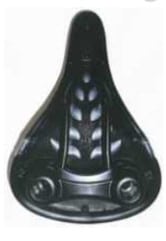In its decision BPatG 30 W (pat) 809/18 of February 27, 2020, the German Federal Patent Court (BPatG) ruled on the question of the visibility of a design in the form of the underside of a bicycle saddle and its intended use and deleted the design reproduced below.
These were so-called components of complex products, more precisely: the underside of a saddle, which was to be understood as a component of a complex product (namely the bicycle).

The associated §4 DesignG requires for such components of complex products that they remain visible when used as intended and that the visible features of the component itself fulfil the requirement of novelty and individual character. To put it simply, there is no design protection for something that is not visible when used as intended.
The question of whether the protected design must “always” be visible in the case of such components of complex products or how far the intended use is to be defined has not yet been conclusively clarified in case law.
The BPatG has taken this matter very seriously in its decision. The conclusion is: A bicycle saddle underside is not eligible for design protection.
From the point of view of the BPatG, the question of visibility when used as intended depends exclusively on the condition of the bicycle seat. This means that the decisive factor here is not the use of the component of a complex product (the saddle), e.g. at the time of purchase or installation, but the use of the complex product itself (in this case the bicycle).
The decisive factor was whether the underside of the saddle is and remains visible when the bicycle is used.
From the point of view of the BPatG, the only “intended” use of a bicycle is riding itself, but not carrying, pushing or parking it. This is because carrying, pushing or parking are formally “normal” uses, i.e. upstream or downstream use, which were not considered in the decision. This is because the “intended” use is defined by the manufacturer’s purpose. On the other hand, measures of maintenance, servicing or repair are already excluded from the concept of intended useunder §1 No. 4 DesignG.
According to the BPatG, the separate design application for the bicycle saddle – and the separation of component and complex product (bicycle) achieved in this way, as well as the visibility achieved, cannot help overcome the hurdle of §4 DesignG in any case.
The logical consequence is also that the time of purchase of the saddle cannot be taken into account, where a bicycle saddle purchased as an individual part can of course also be seen from below. This is also where the practical difference to the 3D trademark becomes apparent!
The BPatG negates the argument that invisibility is eliminated by mere bending. Thus, even those components which are not visible but still “visible” after insertion into a complex product are subject to the exclusion of protection according to § 4 DesignG.
It remains clear that a product which is completely built into another product (complex product) and is not visible when the complex product is used cannot be protected by means of a design.
However, the appeal to the BGH has been admitted, filed and is still pending according to the information of 05.11.20 (BGH file number I ZB 31/20). The last word has therefore not yet been spoken.
